Monuments shall be of a size and shape required by Section 4, Chapter 358 of the Laws of 1953, and shall be placed in accordance with said statute. In addition to the required monuments, after the grading is finished, the developer shall install a steel stake one (1") inch in diameter and thirty (30") inches in length on lot corners, lot line angle points, or other changes in direction not marked by monuments, and at all angle points or discontinuities in easement lines where such easements are not parallel to property lines. (Ord. #686, S 13-8.19)�
In addition to regulations applicable within zones where multi-family dwellings are a permitted use or are a conditional use, the following regulations shall apply to all multi-family dwellings. (Note: the parking location restrictions set forth in Subsection 25-8.21i,1. of this Chapter shall apply to all exterior, existing or proposed public roadways. The parking setback requirements set forth in this section shall apply to all interior roadways, public or private, in multi-family dwelling projects.)�
a. Setbacks from Public Streets. All buildings, parking areas and other above ground improvements, with the exception of access drives or access roadways, landscaping and screening areas, shall be set back a minimum of twenty-five (25') feet from the right-of-way of all public streets unless the required front yard setback for the zone is greater, in which case, the zone regulations shall take precedent.�
b. Setback from Other Property Lines. All buildings, parking areas and other above ground improvements, including access drives, with the exception of landscaping and screening areas, shall be set back a minimum of twenty (20') feet from all side and rear lot lines, unless the required side or rear yard setbacks for the zone are greater, in which case, the zone regulations shall take precedent.�
c. Minimum Distance Between Principal Buildings.�
1. Fifteen (15') feet where neither of the facing walls has windows.�
2. Twenty (20') feet where only one (1) of the facing walls has windows.�
3. Thirty-five (35') feet where both of the facing walls have windows.�
d. Courtyards. Courtyards bounded on three (3) or more sides by wings of the same building or by the walls of separate buildings shall have a minimum court width of two (2') feet for each one (1') foot in height of the tallest building or building wing.�
e. Building Length.. No principal building, when viewed from any elevation, shall be greater than one hundred seventy-five (175') feet in length.�
f. Garages and/or carports, when not attached to a principal building, shall be located no closer than twenty-five (25') feet to a facing wall of a principal building containing windows, nor closer than fifteen (15') feet to a facing wall of a principal building which does not contain windows and shall not face any street external to the site.�
g. Distance Between Principal Buildings and Internal Drives. No multi-family dwellings shall be located closer than twenty-five (25') feet to any access drive or internal roadway.�
h. Distance Between Principal Buildings and Parking Areas. No principal building shall be located closer than twenty (20') feet to any parking area, except for access aisles or driveways to garages and/or carpots, which are attached to principal buildings.�
i. Garage and/or carport parking spaces shall count toward meeting off-street parking requirements in multi-family zones in accordance with Subsection 25-8.21l.1(b)(4).�
j. Refuse Storage. There shall be provided at least one (1) outdoor refuse storage area of at least one hundred (100) square feet for each twenty (20) dwelling units. The refuse storage area shall be suitably located and arranged for access and ease of collection and shall not be part of, restrict or occupy any parking aisle and shall not be located further than three hundred (300') feet from the entrance to any unit which it is intended to serve and shall be screened in accordance with the requirements of Subsection 25-8.4b. of this Chapter.�
k. Outdoor Lighting. Interior development roads, parking areas, dwelling entrance ways and pedestrian walks shall be provided with sufficient illumination to minimize hazards to pedestrians and motor vehicles utilizing the same, but in no case, shall such lighting be less than is required to provide a minimum lighting level of 0.5 horizontal foot candles throughout such areas from dusk to dawn. Where necessary, lights shall be shielded to avoid glare disturbing to occupants of the buildings. Lighting shall be so arranged as to reflect away from all adjoining residential buildings.�
l. Recreation.�
1. Passive recreation area, such as pathways, natural woods and fields, seating areas and lawns, shall be provided, suitably arranged, throughout any multifamily site.�
2. In addition, an active recreation area or areas shall be provided at the rate of at least two hundred fifty (250) square feet per dwelling unit. Outdoor play equipment shall be installed in each recreation area in sufficient amount and variety to service the occupants of the project. If a swimming pool area or areas are to be installed, they are to include a pool of a size at least equivalent to fifteen (15) square feet per unit, except no pool less than eve hundred (500) square feet will be allowed, and no pool greater than three thousand (3,000) square feet shall be required. An auxiliary building or buildings providing for lavoratories and storage shall also be erected in conjunction with pools. Swimming pools shall be subject to the provisions of Subsection 25-8.8 of this Chapter.�
�
3. Contributions in lieu of Active Recreation Areas. If the required active recreation area, or any part thereof, is not provided, then a contribution in lieu of same shall be made to the Borough's recreation fund in accordance with the following formula.�
(a) Total deficiency of active recreation area, in square feet, multiplied by:�
(1) the sum of $30.00 per square foot if the entire site proposed for development area lies in a residential zone (RA, RB, R-B1, R-B2 and RD zones); and/or�
(2) the sum of $50.00 per square foot if any portion of the site proposed for development lies in any Business/Commercial, Mixed Use, Medical Services, Waterfront Development, or Industrial zone (NB, BR-1, BR-2, HB, CCD-1, CCD-2, PO, WD�
�
**Webmasters Note: The subsection above (3) has been added as per Ordinance No. 2006-50.�
�
m. Buildings shall have no more than two (2) dwelling units in a line without setbacks and/or breaks in building elevation of at least five (5') feet.�
n. Concrete walkways, at least four (4') feet wide or of such other dimension and composition as may be approved by the Planning Board, shall be provided where normal pedestrian traffic is likely to occur.�
o. Internal roadways shall be constructed in accordance with the standards for public streets in this Chapter and for developments of more than forty (40) units at least two (2) points of access to primary, arterial or major collector streets must be provided.�
p. Minimum Gross Habitable Floor Area Requirements.�
1. Efficiency Units: seven hundred fifty (750) square feet.�
2. One Bedroom Units: nine-hundred (900) square feet.�
3. Two Bedroom Units: one thousand (1,000) square feet.�
4. Three Bedroom Units: one thousand two hundred fifty (1,250) square feet.�
q. The percentage of three (3) bedroom units to the total number of dwelling units shall not exceed fifty (50%) percent. The combined percentage of two (2) or three (3) bedroom units to the total number of dwelling units shall not exceed eighty (80%) percent. No unit larger than a three (3) bedroom unit shall be permitted.�
r. All rooms, exclusive of living rooms, dining rooms, kitchens and bathrooms, which contain seventy (70) square feet or more of floor area, shall be considered bedrooms. If a dining room is not directly accessible from and adjacent to both the kitchen and living room, it shall also be considered a bedroom.�
(Ord. #686, S 13-8.19)�
a. For every building, structure or part thereof having over ten thousand (10,000) square feet of gross floor area erected and occupied for any use other than residential, there shall be provided at least one (1) truck standing, loading and unloading space on the premises not less than twelve (12') feet in width, thirty-five (35') feet in length and width a minimum vertical clearance of fourteen (14') feet. Buildings that contain in excess of fifteen thousand (15,000) square feet of gross floor area shall be required to provide additional off-street loading spaces as determined by the Municipal Agency during site plan review.�
b. Access to truck standing, loading and unloading areas may be provided directly from a public street or alley or from any right-of-way that will not interfere with public convenience and will permit orderly and safe movement of truck vehicles.�
c. Unless otherwise permitted, fire zones shall not be used as standing, loading or unloading areas.�
d. Loading areas, as required under this section, shall be provided in addition to off-street parking spaces and shall not be considered as supplying off-street parking spaces.�
e. Off-street loading and unloading areas shall conform, as applicable, to all design and locational standards set forth for off-street parking; including, but not limited to, those set forth in Subsection 25-8.21 of the Code of the Borough of Red Bank.�
(Ord. #686, S 13-8.20)�
In all zones and in connection with every industrial, commercial, institutional, professional, recreational, residential or any other use, there shall be provided off-street parking spaces in accordance with the following requirements and parking lot standards:�
a. Type of Parking Permitted. Each dead storage bay of an off-street parking space may be perpendicular with the aisle, parallel with the aisle, or at any angle between sixty (60) degrees and ninety (90) degrees. No angle parking layout shall be permitted with an angle less than sixty (60) degrees.�
b. Stall Size.�
1. Automobiles: Each perpendicular or angle off-street parking space shall occupy a rectangular area of not less than nine (9') feet in width and eighteen (18') feet in depth exclusive of access drives and aisles, except that parking spaces for the physically handicapped shall be twelve (12') feet wide. Parallel parking spaces shall occupy a rectangular area nine (9') feet by twenty-one (21') feet.�
2. Other Vehicles:�
(a) Uses that own, rent or service motor vehicles larger than automobiles which must be parked and/or stored on the site shall indicate in the statement of operations submitted with the site plan, the size of such vehicles and the anticipated largest number of such vehicles to be stored and/or parked on the site at any single time and the site plan shall show a sufficient number of parking and/or storage stalls at an adequate size for the largest number of such vehicles to be parked and/or stored on the site at any one time. Aisles providing for access to such parking and/or storage stalls shall be of adequate width for the vehicles to be served.�
(b) Failure of an applicant to indicate, where applicable, in the statement of operations that vehicles larger than automobiles are to be parked and/or stored on the site and provide for such parking and/or storage on the site plan shall be a violation of this Chapter, and any building permit or Certification of Occupancy that has been issued shall not be valid and may be revoked.�
(c) Any change of use to a use which requires parking and/or storage space for a greater number of vehicles larger than automobiles than the previous use shall be required to make application for site plan approval.�
3. When off-street parking is provided in connection with a use which will assign or can control the utilization of parking areas (for example, employee only parking areas), the Municipal Agency may approve separate parking areas for subcompact vehicles having a length of less than seventeen (17') feet and a width of six (6') feet or less. Within such areas the Municipal Agency may approve the reduction of stall size to eight (8') foot width and a sixteen (16') foot length. Appropriate signing and marking shall be required. The number of parking stalls which may be designed for subcompact vehicles shall be determined by the Municipal Agency based upon documentation submitted by the applicant.�
4. When the Municipal Agency determines that offstreet parking is proposed in connection with an industrial or business use, primarily for occupancy by employees who park for a full shift, for long-term parking related to transportation uses or for similar uses with low space turnover (parking duration approaching or exceeding eight hours), the Municipal Agency may approve a reduced parking stall width; however, in no event shall stall width be less than eight (8') feet for conventional spaces and seven (7') feet for subcompact vehicle spaces.�
c. Aisle Widths.�
1. Two-way aisles shall be not less than twenty-four (24') feet wide.�
2. One-way aisles from which cars directly enter or leave parking spaces shall not be less than twenty- four (24') feet wide for perpendicular parking or for parking at any angle greater than seventy-five (75) degrees, twenty (20') feet wide for parking at any angle greater than sixty (60) degrees and eighteen (18') feet wide for parking at any angle greater than forty-five (45) degrees.�
3. Only angle parking stalls or parallel parking stalls shall be used with one-way aisles.�
d. Access Drives. (See Figures XI and XII)�
1. Entrance and exit drives shall have a minimum width of eighteen (18') feet for those designed for a one-way traffic and twenty-four (24') feet for those carrying. two-way. traffic.�
2. Parking areas for twenty-five (25) or more cars and access drives for all parking areas on arterial highways shall provide curbed return radii of not less than fifteen (15') feet for all right turn movements and left turn access from one-way streets and concrete aprons on entrance and exit drives.�
3. Parking areas for less than twenty-five (25) cars mmay utilize concrete aprons without curb returns at entrance and exit drives which are not located on a minor arterial or principal arterial highway.�
4. The Municipal Agency may require that access drives for developments of one hundred (100) or more spaces be designed in accordance with requirements for municipal streets.�
5. Access drives for single and two (2) family dwellings shall utilize concrete aprons without curb returns regardless of size or location. Such drives shall have a minimum width of ten (10') feet and a maximum width of twelve (12') feet when they provide access to a one-car garage (or when there is no garage; or a maximum width of twenty-four (24') feet when they provide access to a two (2) car (or larger) garage. All such drives shall be paved as provided by Subsection 25-8.21n.1.�
6. Maximum curb depression width for single and two (2) family dwellings shall be the driveway width plus four (4') feet, but not more than twenty-five (25') feet, and for all other uses shall be the driveway width plus ten (10') feet, but not more than thirtyfive (35') feet.�
7. All aprons, drives, curbs and aisles shall be arranged so as to provide at least three (3') foot clearance from adjacent property lines (or from extensions of property lines to the street line).�

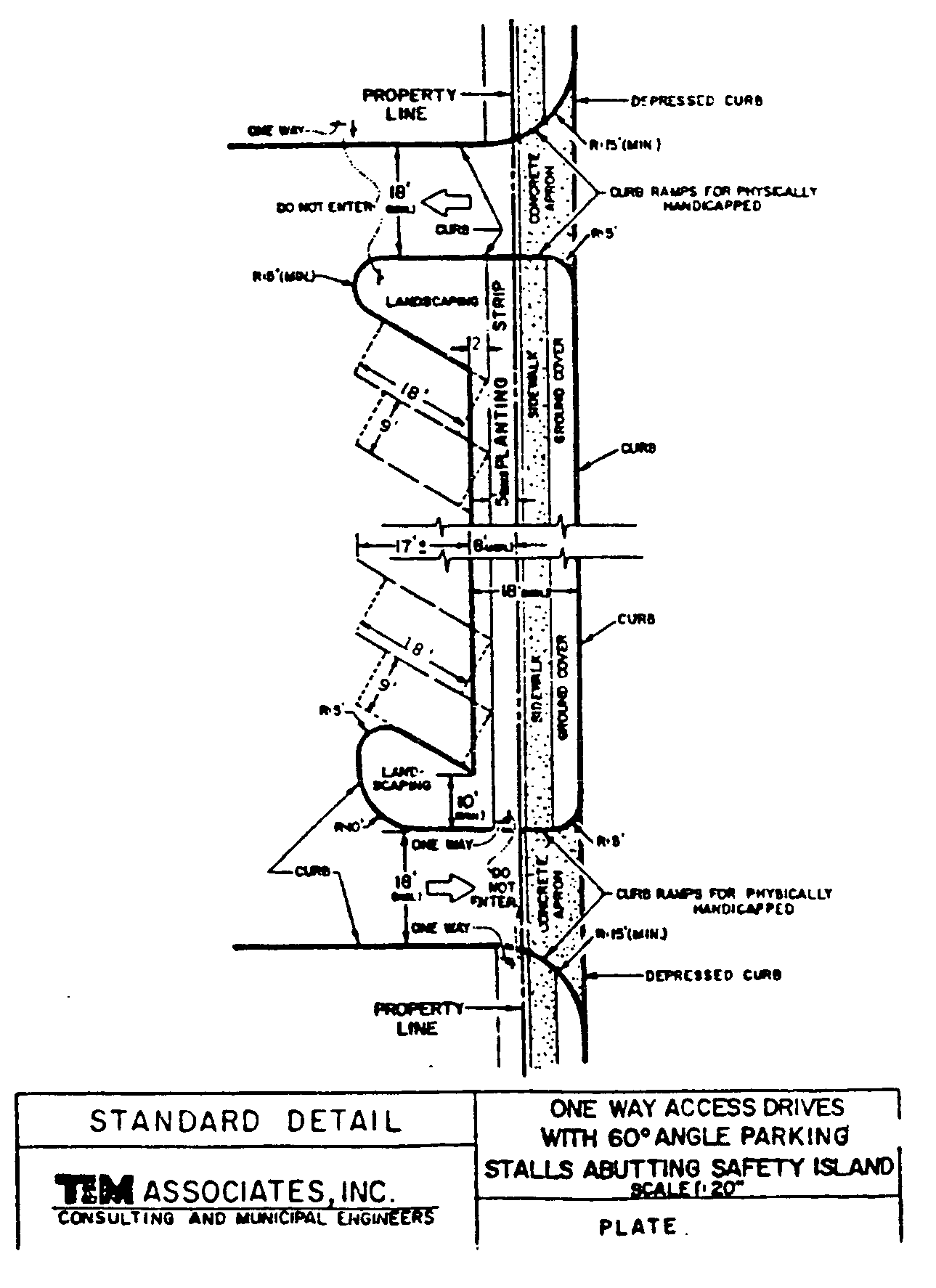
e. Paint Striping. All parking areas shall provide paint striping to delineate parking stalls, barrier lines, lane lines, directional arrows, stop lines, fire lanes and other striping as may be required to ensure safe and convenient traffic circulation. Such striping shall be in substantial conformance with the Uniform Manual on Traffic Control Devices except that all parking stall marking shall be "hairpin" style with eight (8") inches between parallel stall dividing lines.�
f. Traffic Signs. All parking areas shall provide traffic control signs and devices necessary to ensure safe and convenient traffic circulation. Such devices shall be in substantial conformance with the Uniform Manual on Traffic Control Devices.�
g. Curbing. The perimeter of all parking areas and internal islands within all parking areas open to the general public shall have continuous cast in place concrete curbing (see Figure No. 9) with a six (6") inch face or such alternate curb types as may be approved by the Municipal Agency at the time of site plan approval. The Municipal Agency may waive the requirement for curb in parking areas open only to employees, service vehicles or for loading and unloading, provided that drainage, vehicle control and safety can be properly accommodated by alternate means.�
h. Paving. All parking areas shall provide pavement in accordance with the requirements of local streets set forth in Subsection 25-8.23 of this Chapter, except as follows:�
1. Parking areas for less than fifty (50) cars, which the Municipal Agency determines are not likely to be utilized by heavy truck traffic or drive-up window service, may be paved with two (2") inches of pavement, Type FA-BC-1 over a six (6") inch gravel base, all in accordance with the specifications contained in Subsection 25-8.23. Rigid Portland cement concrete pavement may be utilized at the option of the applicant who shall submit pavement. details for review. Minimum requirements shall be a thickness not less than five (5") inches, reinforcing at least equivalent to welded wire fabric (66-1212), Class "C" concrete (air-entrained) and appropriate expansion and/or contraction joints.�
2. In parking areas for one hundred (100) or more cars, access drives and aisles, which the Municipal Agency determines are likely to be utilized by heavy trucks or unusually high traffic volumes, shall provide paving in accordance with the requirements for local, local collector and minor collector streets set forth in Subsection 25-8.23 of this Chapter.�
i. Provisions for the Locations of Parking Spaces; Safety Islands and Raised Medians and Handicapped Parking.�
1. Location of Parking Spaces.�
(a) Parking for all uses in all zones shall not be located in any required front yard area, nor between any existing or proposed building (or the extension of the planes of the exterior surface of any existing or proposed building to the lot boundaries) and any street right-of-way line; except that parking for single and two (2) family dwellings shall not be subject to yard area location restrictions, but shall only be permitted in access drives meeting the requirements of Subsection 25-8.21 d.�
(b) Garages for single and two (2) family dwellings, the following shall apply:�
(1) Garage space may provide for both or for one of the required spaces and a second space may be arranged in tandem.�
(2) Except for attached single family dwellings, garages, whether attached or detached, shall be arranged to open to the side or rear of the lot except fully detached garages, located entirely to the rear of the principal building.�
(3) If no garage is provided, the parking spaces required by this Chapter may not be located in any required front setback area not withstanding that parking is permitted in front setback area by Subsection 25-8.21l,1. of this Chapter.�
(4)For uses other than single and two (2) family dwellings, the following shall apply space:�
(i) Garage space may provide the required parking spaces for all uses except multi-family dwellings.�
(ii) For multi-family dwellings, each garage space will count as 0.5 of a required space, unless there is provided a driveway at least twenty (20') feet long in front of the garage, in which case each garage shall count as 1.3 of a required space.�
(c) All required parking spaces and facilities shall be located on the same lot or parcel as the structure or use it shall serve except, in the case of non-residential uses, parking facilities may be provided on other lots or parcels within a radius of five hundred (500') feet from the boundary of the lot containing the principal use and subject to deed restrictions binding the owner and his heirs, successors and assigns to maintain the required number of spaces available and required facilities throughout the life of such use.�
2. Safety Islands and Raised Medians. Where parking, other than single and two (2) family dwellings, is permitted between the front building line, whether by variance or by approval of a design deficiency, a safety island or raised median separating the public street from the parking area shall be provided in accordance with the following minimum requirements (see Figures XI and XII):�
(a) The width of the safety island shall be that width between the proposed curb line to a point eight (8') feet inside the property line. When this width is less than eighteen (18') feet, the parking area shall be reduced to provide a minimum width for the safety island of eighteen (18') feet. All required tree and shrub plantings shall be placed on the on-site portion of the safety island.�
(b) When perpendicular or angled parking spaces abut the safety island, the stall depth shall be measured from a point one (1) foot outside the face of the curb for perpendicular spaces or angled spaces greater than sixty (60) degree angle spaces. Such parking spaces shall be separated from access drives by curbed islands with a minimum width of ten (10') feet.�
(c) Safety islands shall be landscaped, topsoiled, and seeded, except that they may, as an alternative to seeding, be provided with a cover or mulch of maintenance free materials which provide a clear and unmistakable distinction between the parking area and the safety island.�
(d) Notwithstanding the use of maintenance free materials, there shall be provided at least one (1) deciduous tree two (2") inches in diameter at breast height every forty (40') feet, or part thereof, on all for plantings if necessary for traffic safety. The area between trees shall he planted with a minimum of three (3) evergreen type shurbs. The portions of the safety island within twenty-five (25') feet of any access drive or street intersection shall be planted with evergreen shrubs less than thirty (30") inches in height. Alternate or additional plantings may be permitted by the Municipal Agency in accordance with an approved site plan.�
(e) No commercial signs, light standards or other above ground obstructions other than plantings shall be permitted within ten (10') feet of the street right-of-oway.�
3. Handicapped Parking. Required parking spaces for the physically handicapped should be located to provide convenient access to building entrances by way of depressed curbs and ramps in accordance with State regulations. Parking spaces for the physically handicapped shall be a minimum of twelve (12') feet in width and the number of spaces to be provided shall be determined by the following table:�

j. Small Parking Areas. Parking lots having fifty (50) or less spaces shall be designed to provide the following minimum design requirements:�
1. A safety island where parking is provided in the front yard area.�
2. A five (5') foot unbroken landscaping strip along side and rear property lines. The five (5') foot landscaping strips shall have the same minimum planting requirements as safety islands, except that:�
(a) Where screening is required under this Chapter, the screening requirements shall take precedence.�
(b) Where the property abuts a lot zoned for nonresidential purposes, but utilized for residential purposes, the Planning Board may also require screening.�
3. Not more than one (1) two-way drive or two (2) one-way drives shall be permitted on any street.�
4. Where possible, access drives shall not be located closer than one hundred (100') feet from the nearest right-of-way line of an intersecting street.�
5. No parking stall shall be located to require a vehicle to back into any portion of the right-of-way in order to enter or exit the parking stall.�
6. All parking areas for ten (10) or more vehicles shall have artificial lighting that will provide a minimum lighting level of 0.5 horizontal foot candles throughout the parking area and access drives. For multifamily uses, such lights shall be operated from dusk to dawn and for all other uses when the site or structure is occupied. Free standing light poles shall be no higher than the height of the highest principal building plus five (5') feet. Shielding shall be required where necessary to prevent glare upon adjacent properties or streets.�
k. Large Parking Areas. Parking lots which have a capacity for parking more than fifty (50) vehicles shall incorporate the following minimum design standards:�
1. All the minimum design standards for small parking areas.�
2. All entrance drives shall extend a minimum distance of one hundred (100') feet back from the street curb line or to an access aisle.�
3. All exit drives shall extend a minimum distance of sixty (60') feet back from the street curb or to a major access aisle.�
4. No parking stalls shall utilize the required entrance and exit drives or major circulation drives as access aisles.�
5. Wherever feasible, access drives located along one-way streets or divided highways shall be separate one-way drives. The drives shall be located so that vehicles enter the parking area at the beginning of the property and exit at the far end of the property unless other considerations, such as a median opening, dictate otherwise.�
6. Access drives shall not be located closer than one hundred (100') feet from the nearest right-of-way line of an intersecting street, except that for uses such as shopping centers, which in the opinion of the Municipal Agency will generate large traffic volume, access drives shall not be located closer than two hundred (200') feet from the nearest right-of-way line of an intersecting street.�
7. No driveway shall be located less than ten (10') feet from the side property line or within thirty (30') feet of an existing drive, whichever is greater.�
8. Properties having a frontage in excess of five hundred (500') feet on any one street shall be permitted two-way and one-way access drives providing for not more than two (2) entrance and two (2) exit movements on the street. Properties having a frontage in excess of one thousand (1,000') feet on any one street may be permitted to have additional access drives subject to the approval of the Planning Board.�
9. Where the Municipal Agency determines that the total number of off-street parking spaces required by this Chapter may not be immediately required for a particular use, it may permit a staged development plan, which requires that only a portion of the parking area, but not less than seventy-five (75'%) percent of the required spaces, be completed initially, subject to the following regulations:�
�
(a) The site plan shall clearly indicate both that portion of the parking area to be initially paved and the total parking needed to provide the number of spaces required by this Chapter.�
(b) The site plan shall provide for adequate drainage of both the partial and total parking areas.�
(c) The portion of the parking areas not to be paved initially shall be landscaped in accordance with Subsection 25-8.4c. of this Chapter.�
(d) The applicant shall post separate performance guarantees in addition to the performance guarantees required under Article VII of this Chapter which shall reflect the cost of installing the additional parking facilities necessary to provide the total number of parking spaces required.�
(e) In lieu of a permanent Certificate of Occupancy, a temporary Certificate of Occupancy shall be issued for a period of two (2) years. Prior to the expiration of the two (2) year period, the applicant may either (1) install the additional parking shown on the site plan and apply to the Construction Official for issuance of a permanent Certificate of Occupancy or (2) apply to the Municipal Agency after the use has been in operation a minimum of eighteen (18) months for a determination as to whether or not the initial parking area provided is adequate. If the Municipal Agency determines that the parking facility is adequate as originally constructed, the performance guarantees may be released and a permanent Certificate of Occupancy issued. If, however, the Municipal Agency determines that the partial off-street parking area is not adequate, the applicant shall be required to install the additional parking facilities in accordance with the terms of the performance guarantees prior to issuance of a permanent Certificate of Occupancy.�
(f) Any change of use on a site for which the Municipal Agency may have approved a partial paving of off-street parking areas, to a use which requires more parking spaces than are provided on the site, shall require submission of a new site plan.�
l. Parking Area Landscaping. Every parking lot with more than one hundred (100) spaces shall be divided as nearly as possible into smaller lots of fifty (50) spaces separated by landscaped dividing strips, excepting the area for access aisles. The plantings required within the parking area shall be considered exclusive from any other plantings that may be required for screening or safety island planting. All landscaping for dividing strips shall be shown as part of the detailed landscaping plan submission, where required. The following criteria shall apply for internal landscaped dividing strips:�
1. They shall have a minimum width of ten (10') feet.�
2. They shall be seeded and topsoiled. The use of maintenance free material other than seeding and topsoil may be permitted if the same provides a safe and attractive alternative.�
3. Unless otherwise approved by the Municipal Agency, they shall be planted with deciduous trees of two (2") inch diameter at breast height with a maximum distance between trees at ground level of forty (40') feet. All trees shall be planted in accordance with the appropriate requirements of Subsection 25-8.4. The area between trees shall be planted with a minimum of three (3) evergreen type shrubs.�
4. The depth of perpendicular or angled parking stalls, which abut a landscaped dividing strip, shall be measured from a point one (1') foot outside the face of the curb for perpendicular spaces or angled spaces greater than sixty (60) degrees and two (2') feet outside the face of the curb for sixty (60) degree angles spaces.�
5. All portions of every site, not utilized for pedestrian paths, parking, access drives, loading areas or approved outdoor storage and not covered by buildings or other construction shall be landscaped as provided in Subsection 25-8.4 of this Chapter. This shall include areas immediately adjacent to the site on public right-of-ways between curb and sidewalk or the property line of the site.�
m. Retaining Walls and Embankment Slopes.�
1. In the event that parking is proposed on a lot or site having a slope greater than ten (10%) percent, regardless of size, it shall be terraced, utilizing retaining walls or properly reinforced embankment slopes and providing for adequate safety, stability and drainage. At no time should an embankment slope that is not reinforced, or any other earthen material having a greater elevation than the adjacent parking area, have a slope exceeding a ratio of three to one (3:1).�
2. When retaining walls, terraces, embankment slopes or similar types of earthen retaining devices are necessitated adjacent to or within the parking area, they shall be kept in good repair or otherwise maintained so as to keep the parking area free of debris and dirt.�
n. Access to Adjoining Property. No unrestricted vehicular access shall be permitted between adjacent properties. Vehicular access, if agreed upon by the owners or possessors of adjacent properties, or if required by the Municipal Agency shall normally be limited to one (1) opening providing two (2) lanes of traffic and shall be located in such a manner as to offer continuity of a similar access drive on the adjacent property. The opening shall occur at a point having the greatest distance from the street line which would facilitate the joining of properties. Access shall normally be denied across the remainder of the side lines by construction of a landscaped dividing strip, five (5') feet in width on the property being developed. If and when the adjacent property is developed, there shall be a similar dividing strip at least five (5') feet wide. All dividing strips shall be landscaped as provided in this section. The Municipal Agency may also require that provision be made for future connection to adjacent undeveloped properties.�
o. Minimum Off-Street Parking Spaces Required.�
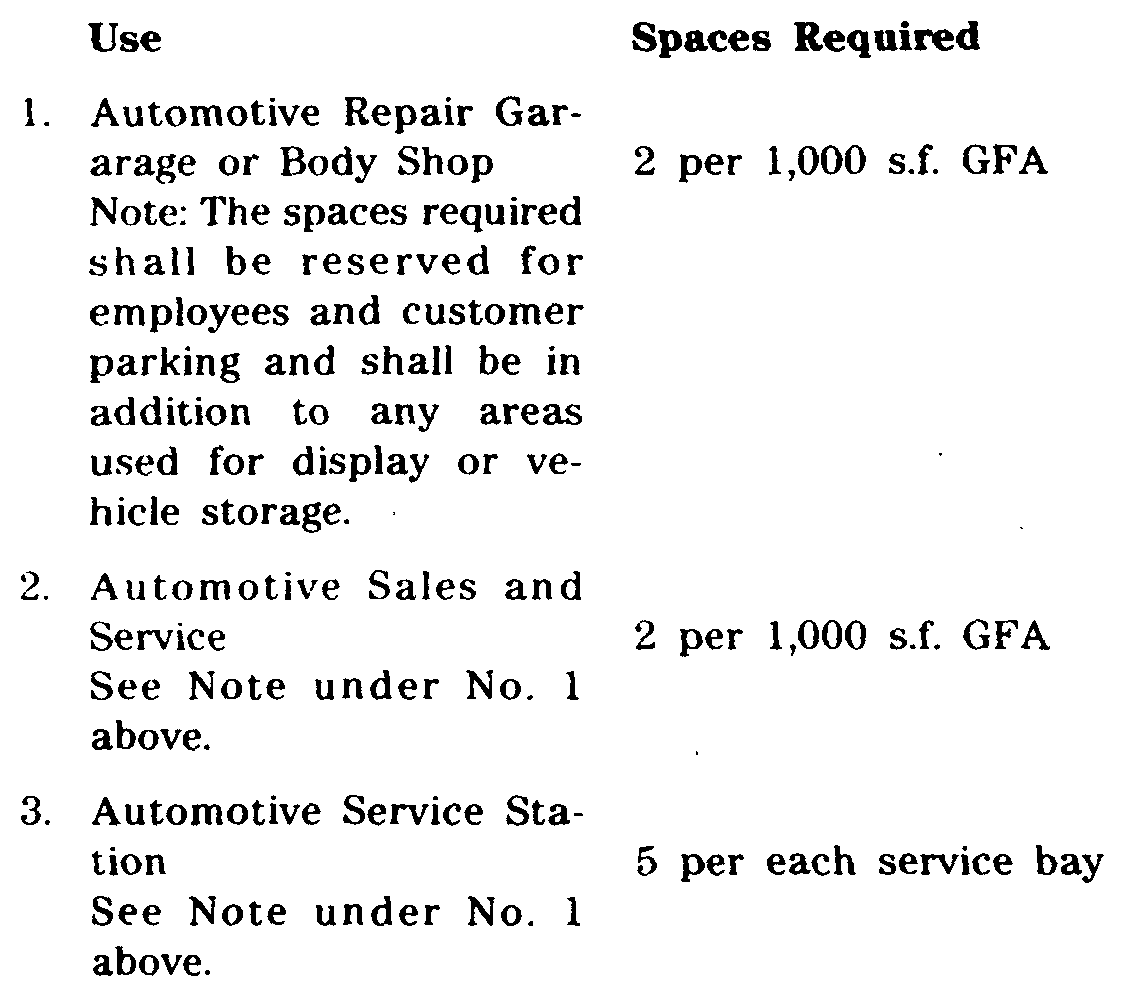
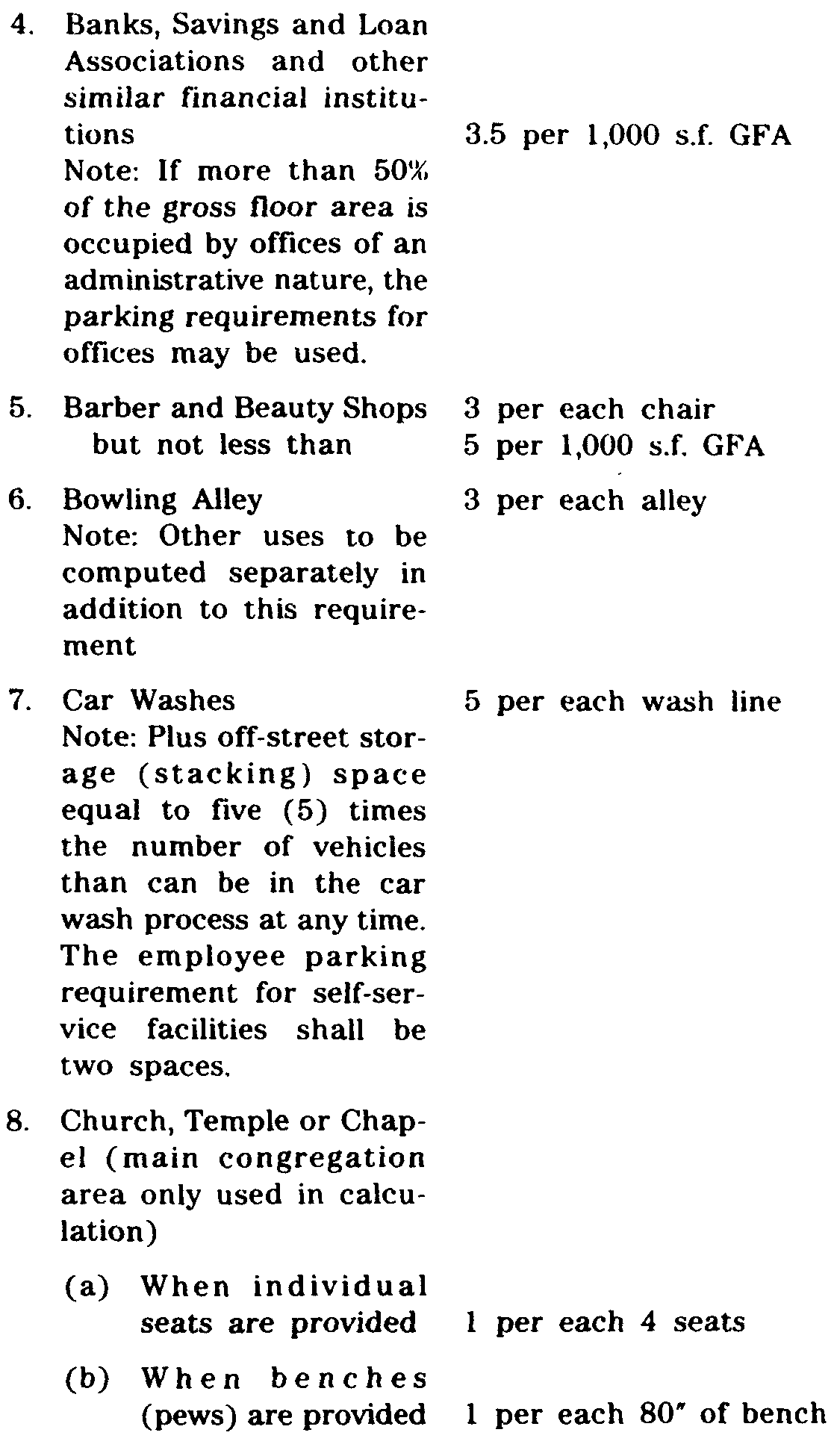
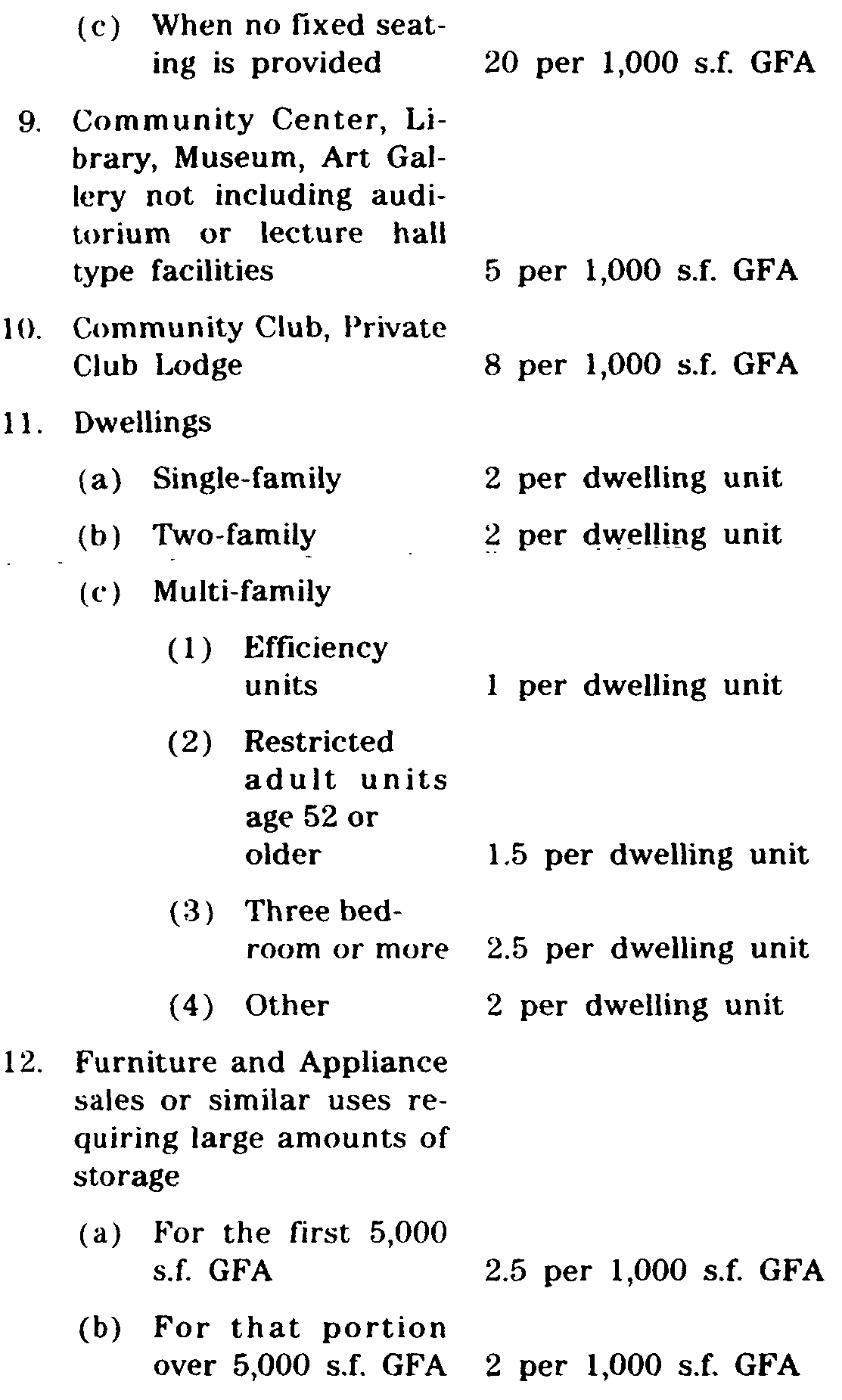
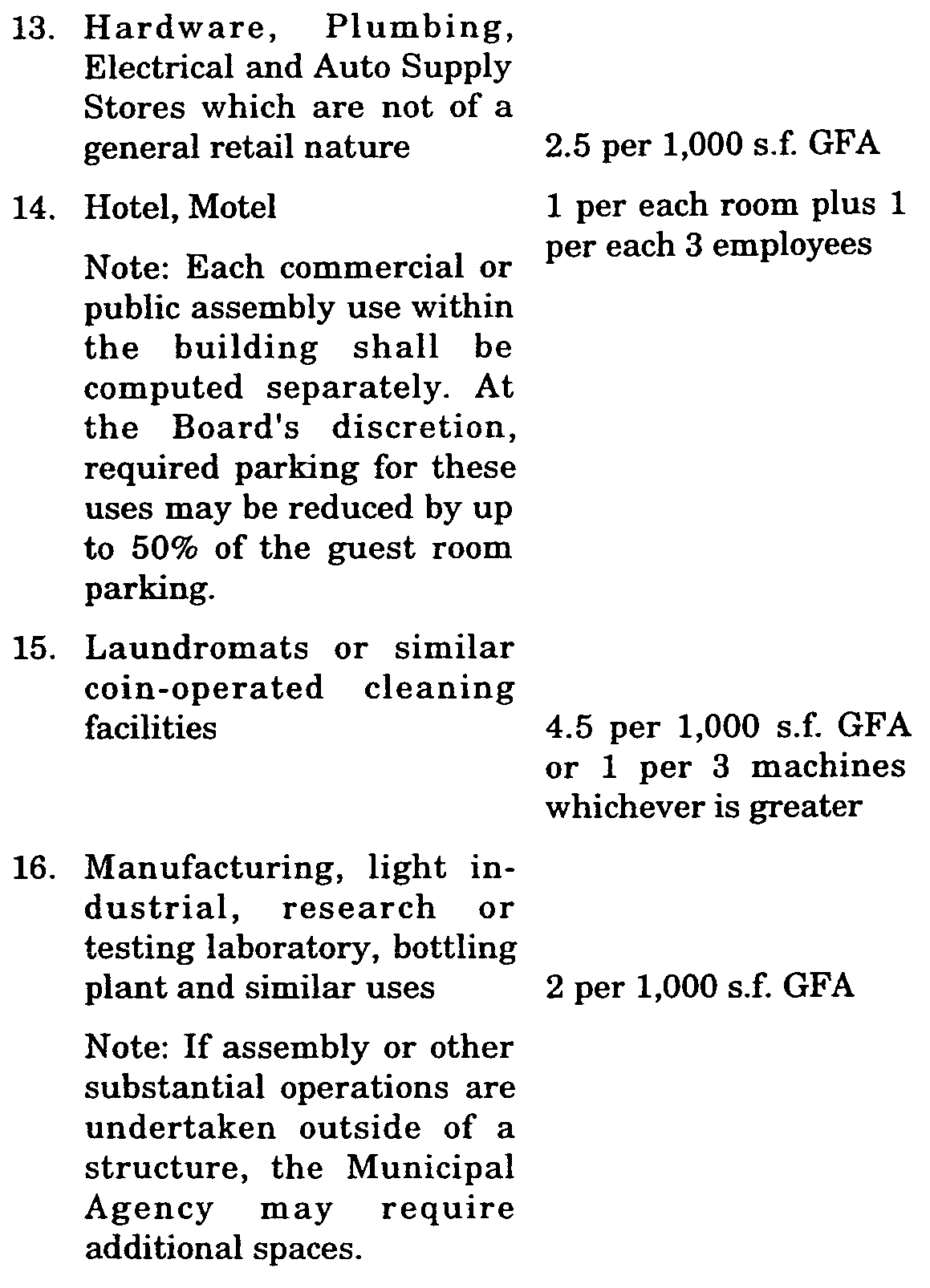

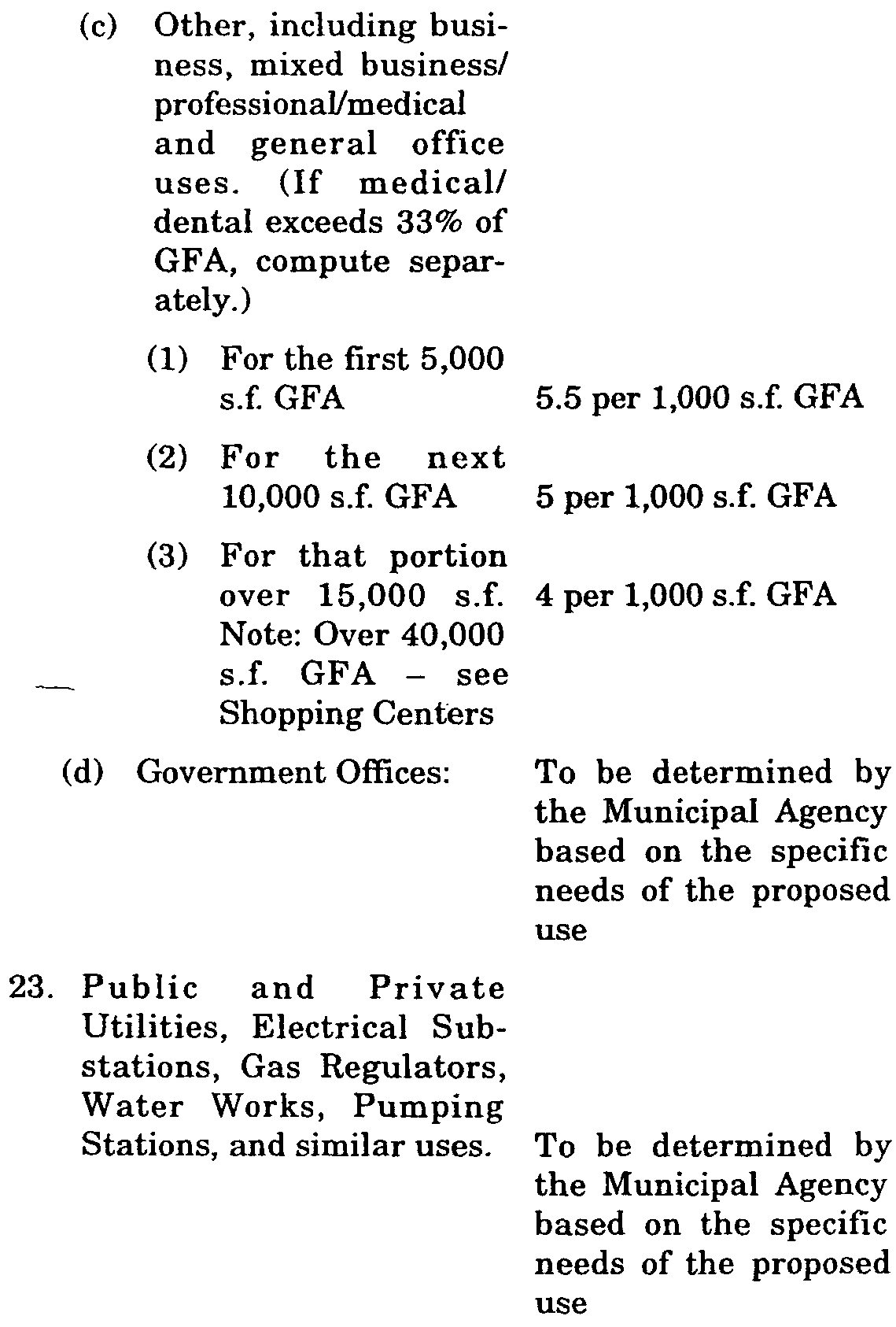
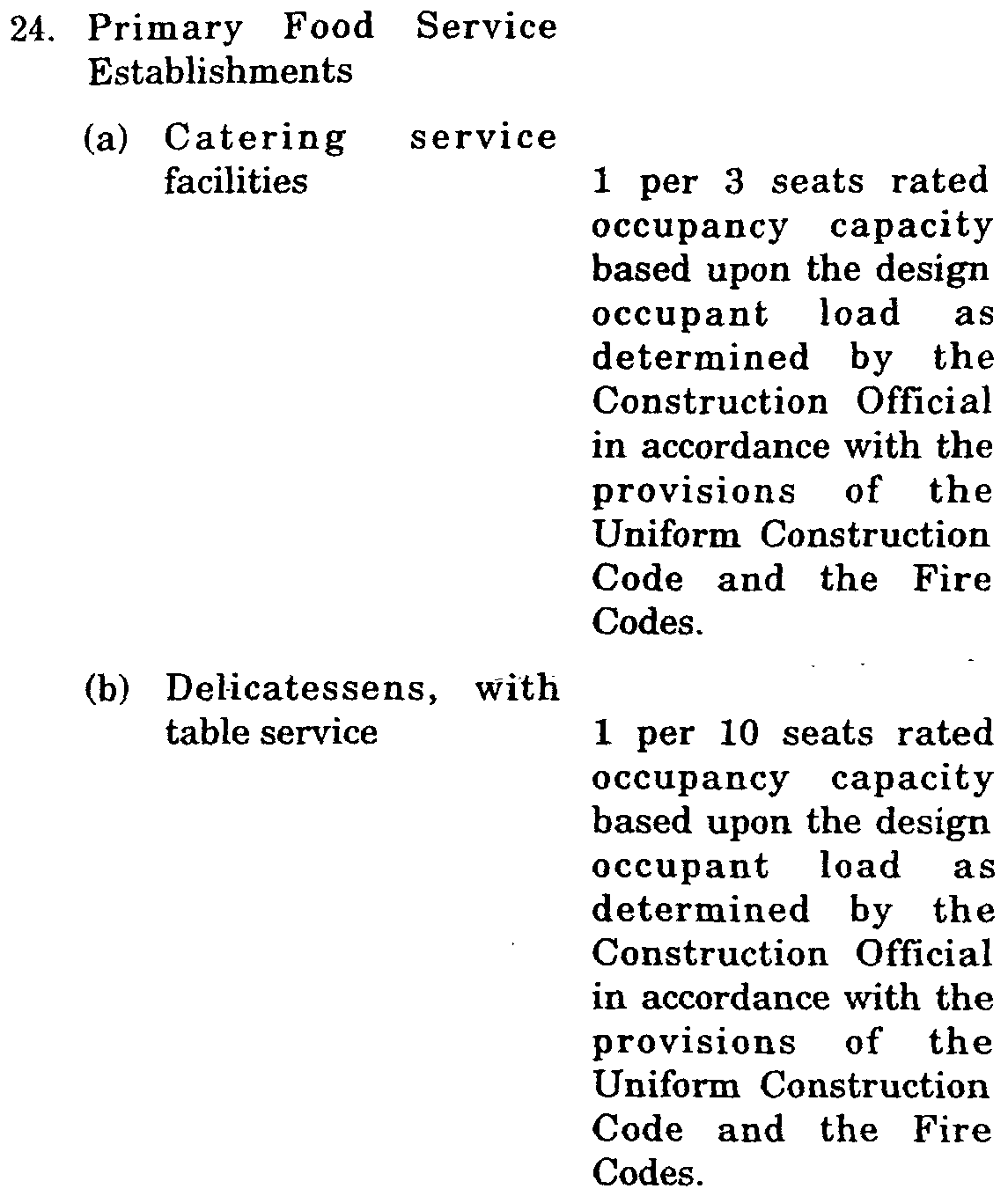

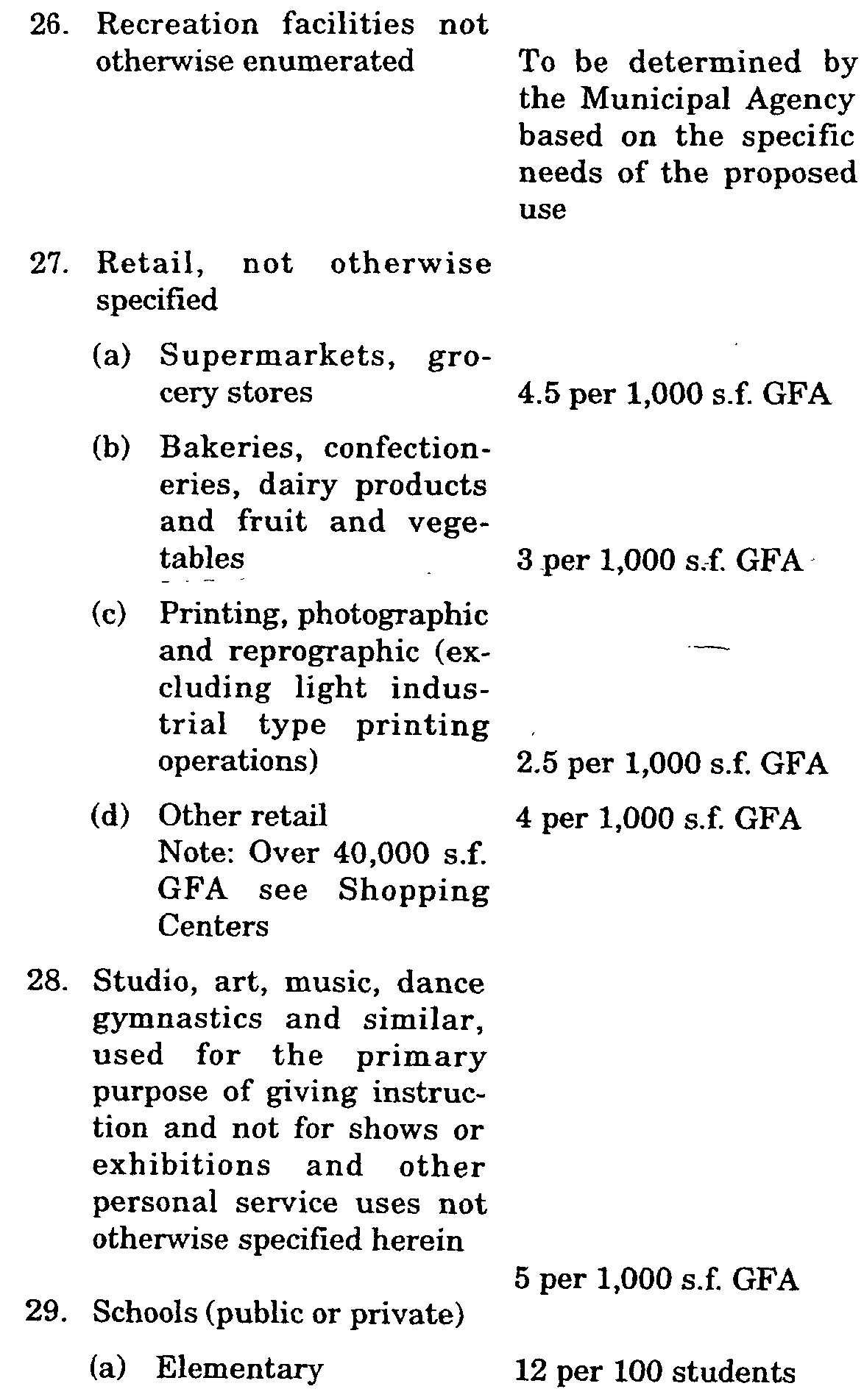
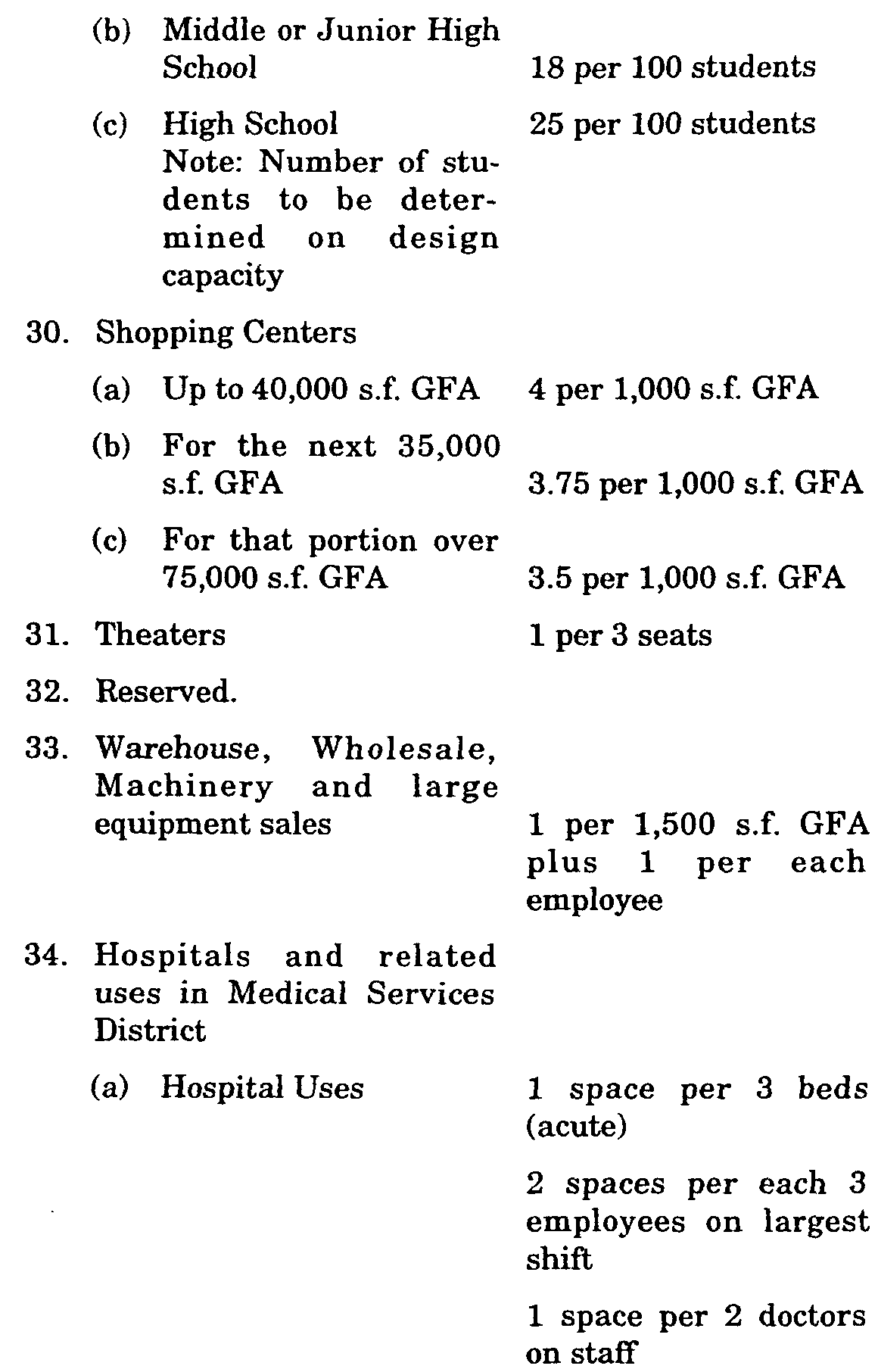
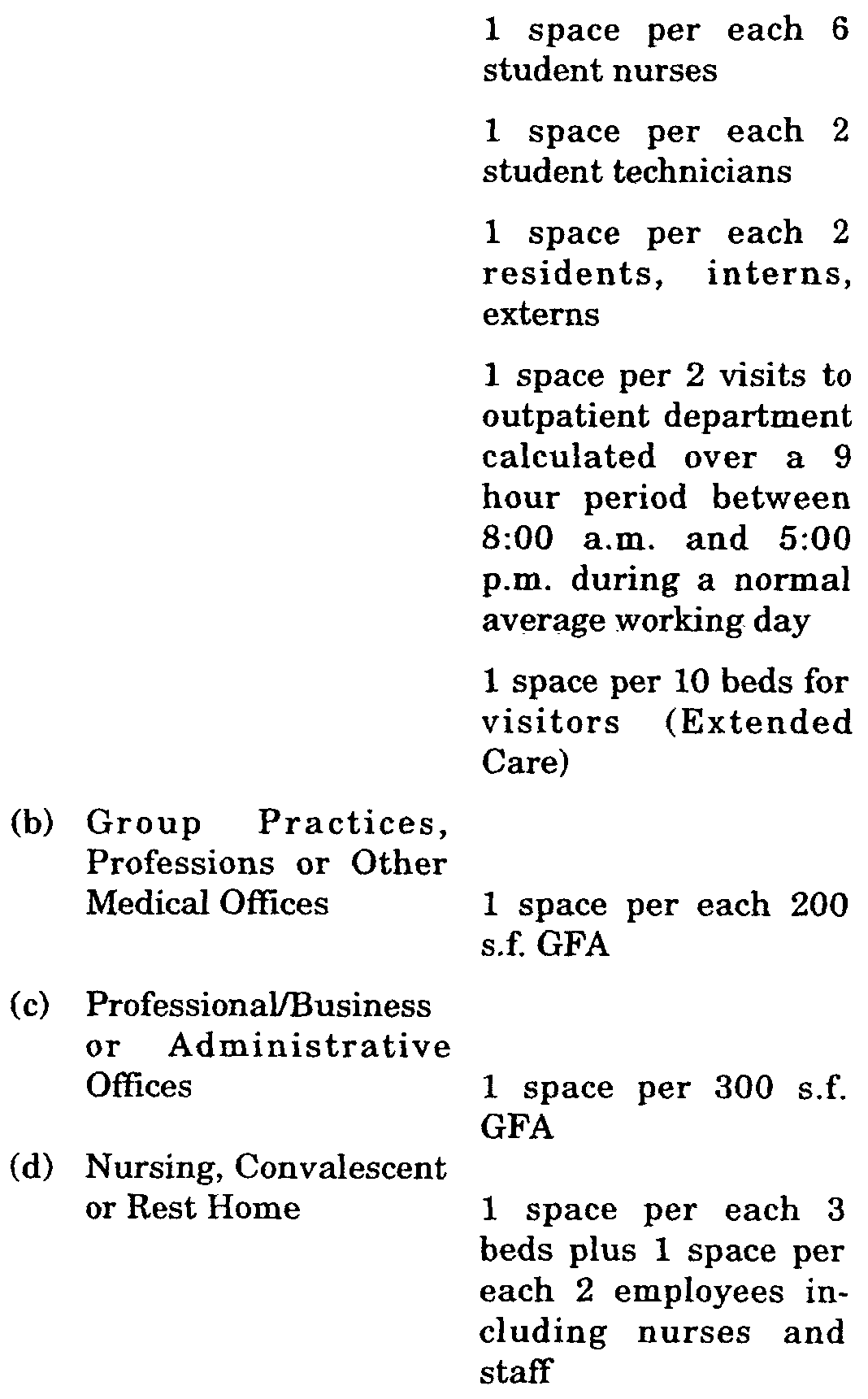
p. Criteria for Determining Required Parking Spaces. In computing the number of the above required parking spaces, the following rules shall govern:�
1. Where fractional spaces result, the required number shall be construed to be the nearest whole number.�
2. The parking space requirements for a use not specifically mentioned herein shall be the same as required for a use of similar nature as determined by the Municipal Agency based upon that use mentioned herein which is most similar to the proposed use. If there is no use enumerated herein having sufficient similarity to the use proposed to enable the Municipal Agency to establish rational parking requirements, the Municipal Agency may, in its discretion, direct the applicant to furnish the Municipal Agency with such data as may be necessary to enable the Municipal Agency to establish rational parking requirements.�
3. Nothing in the above requirements or in this subsection shall be construed to prevent the joint use of off-street parking facilities by three (3) or more uses on the same site (which will be termed "shared parking").�
(a) Application prerequisites for the use of shared parking:�
(1) The land uses and common parking facility must be owned by the same developer/owner and located in close proximity to one another.�
(2) Parking spaces to be shared should not be preserved for certain individuals or groups on a twenty-four (24) hour basis.�
(3) Any subsequent change in land uses within the mixed-use development will require proof that sufficient parking will be available.�
(4) The applicant shall agree to establish and maintain facility operational characteristics which will accommodate, maintain and encourage the shared parking concept. The applicant will provide assurances, sufficient to satisfy the Municipal Agency, that such operational characteristics, including, but not limited to, hours, space assignments, security, rates and ownership and control will complement the shared parking concept. If the Municipal Agency determines it necessary, it may require execution of a developer's agreement (or similar operation agreement) between the developer and the Borough Council (or other parties concerned) to assure the effectiveness of the shared parking concept pro posed by the applicant.�
(b) Periods of Peak Parking Accumulation. According to recent studies, typical periods of peak accumulation for land use that can utilize shared parking include:�
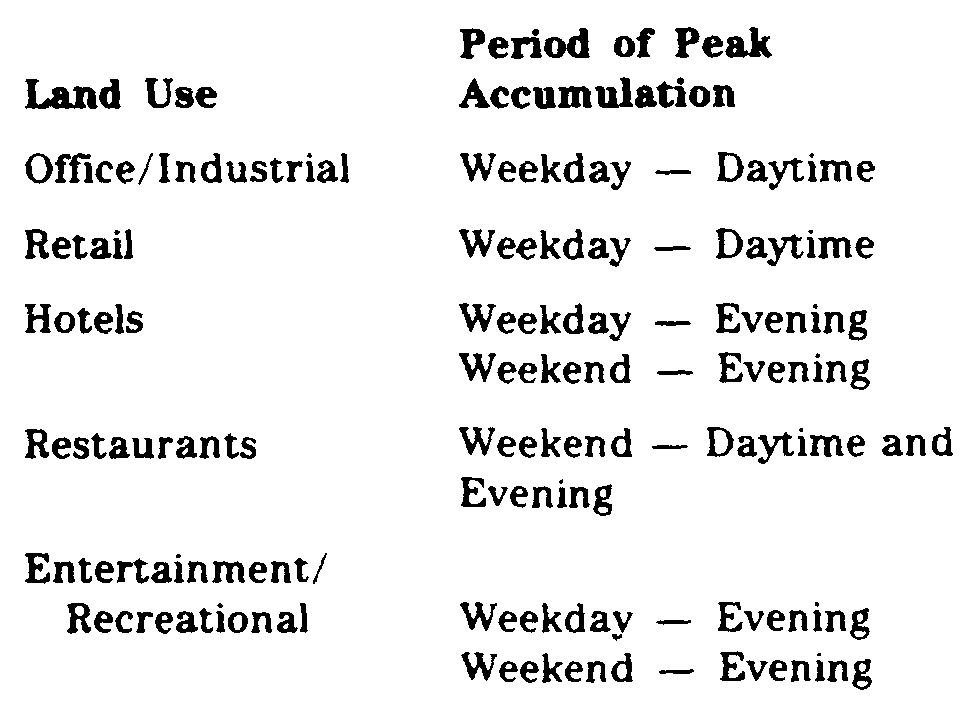
(c) Percent Standards for Shared Parking. The following percentages are to be used for calculating Shared Parking:�
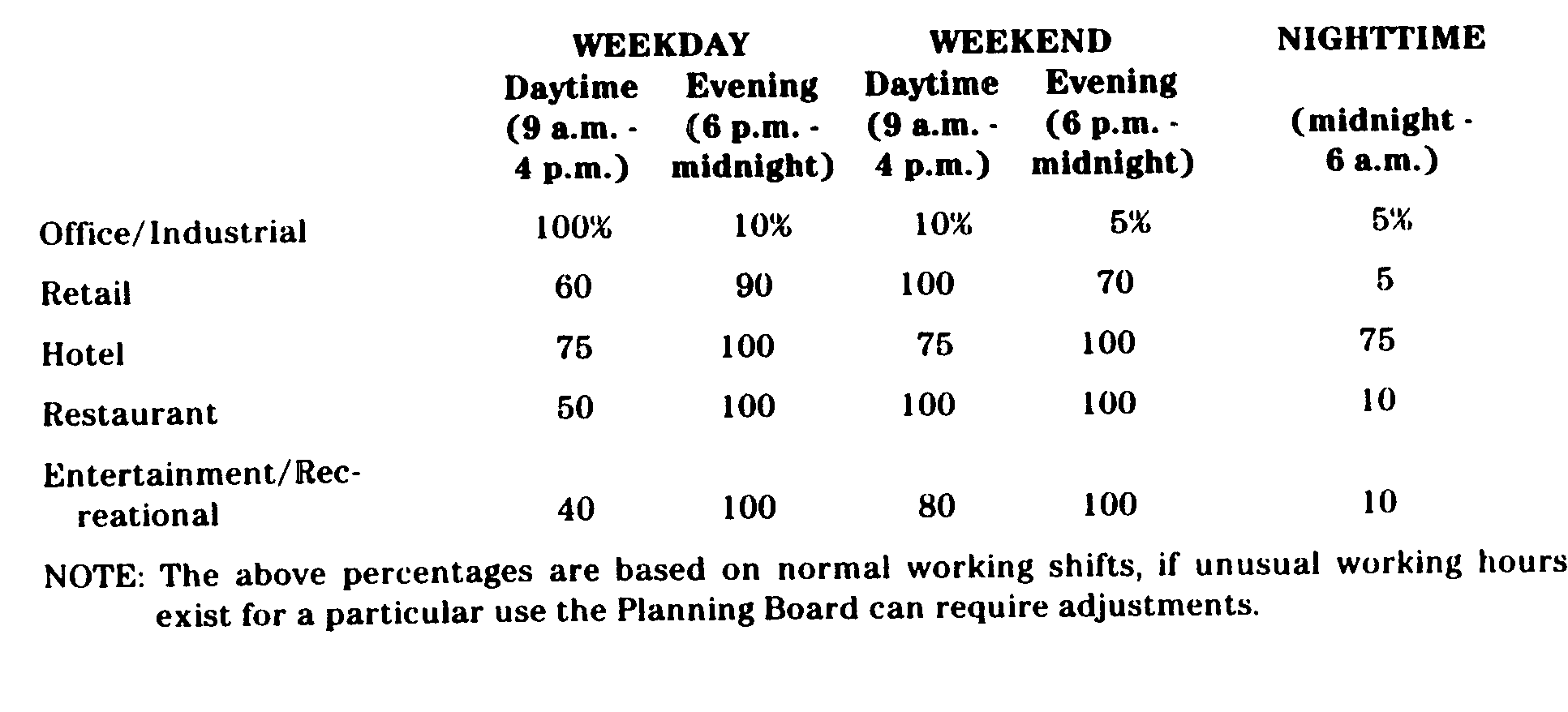
(d) Calculation Methodology.�
(1) Determine the minimum amount of parking required for each land use as though it were a separate use;�
(2) Multiply each amount by the corresponding percentage for each of the five (5) time periods;�
(3) Calculate the column total for each time period;�
(4) The column total with the highest value is the parking space requirement subject to reduction for size.�
(5) Reduction for Size. The parking requirement determined from the calculation procedures shall be reduced as follows:�
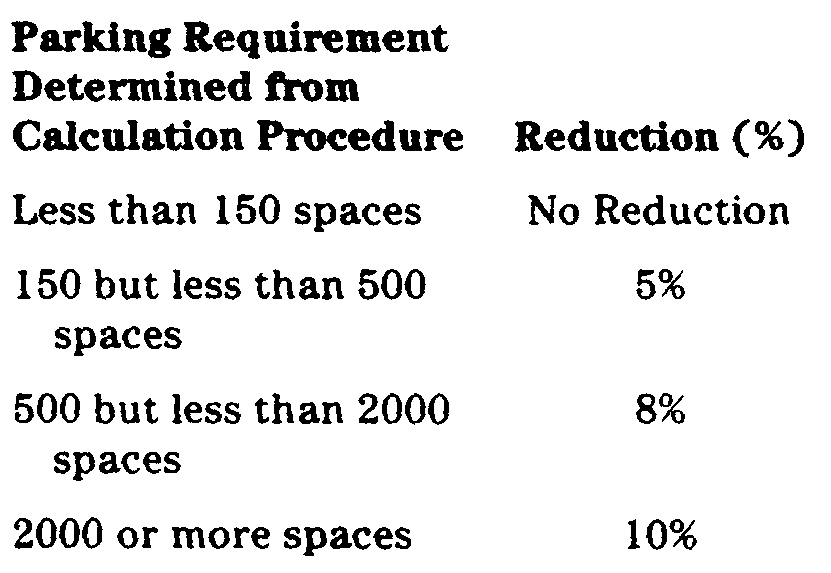
NOTE: Residential uses are not included in the shared parking standards because this use usually has reserved parking spaces for residents. The reservation of parking areas would preclude the sharing of these spaces. If an applicant can justify and demonstrate that residential parking would not be reserved, the Planning Board at its discretion may permit shared residential parking.�
�
4. No part of off-street parking required by a structure or use shall be included as part of an off-street parking requirement of another use unless substantial proof and assurances are presented and it is determined by the Municipal Agency that the use of this parking will not be simultaneous.�
5. The Municipal Agency may consider requests for design waivers or design deficiency approvals for deficient parking provided at least ninety (90%) percent of the parking spaces required by this subsection are proposed. If less than ninety (90%) percent of the parking spaces required by this subsection are proposed, an application for a bulk variance must be made by the applicant.�
6. An application for a parking space variance (a deficiency of more than ten (10%) percent must, when such deficiency is fifteen (15) or more spaces, include a report by and, where applicable, testimony by a traffic engineer, or other person with particular expertise in parking acceptable to the Municipal Agency, in order to assess the probable impact of the proposed deficiency on the site, on affected nearby properties and on existing parking supply and traffic patterns in the vicinity of the site.�
7. This Chapter requires, unless specifically waived by the Municipal Agency, a contribution to the Red Bank Borough Municipal Parking Utility Capital Improvement Fund, for each required space not provided in the CBD, CCBD and SBD-2 Zone Districts or in connection with MXRD or MXCD Conditional Uses. The Municipal Agency may consider the need for such contributions when reviewing requests for parking spaces variances in other zone districts. If the Municipal Agency finds that the general parking supply is likely to be impacted by a variance request it may impose a requirement for similar contributions in any zone district.�
(Ord. #686, S 25-8.21; Ord. #1988-21, SS 5-7; Ord. #1990-23, S 2; Ord. #1999-6, S 5)�